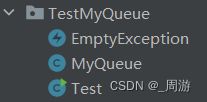【数据结构】_6.队列
目录
1.概念
2.队列的使用
3.队列模拟实现
4.循环队列
5.双端队列
6.OJ题
6.1 用队列实现栈
6.2 用栈实现队列
1.概念
(1)队列是只允许在一端进行插入数据操作,在另一端进行删除数据操作的特殊线性表;
(2)队列具有先进先出,后进后出的特点;
(3)入队列:进行插入操作的一端称为队尾;
出队列:进行删除操作的一端称为队头;
2.队列的使用
在java中,Queue是个接口,底层是通过链表实现的,其常用方法如下:
| 方法 | 功能 |
| boolean offer(E e) | 入队列 |
| E poll() | 出队列 |
| peek() | 获取队头元素 |
| int size() | 获取队列中有效元素的个数 |
| boolean isEmpty() | 检测队列是否为空 |
3.队列模拟实现
(1)包类关系:
(2)TestMyQueue:
package TestMyQueue;
import TestMyStack.EmptyException;
public class MyQueue {
// 使用单链表实现队列
static class Node{
public int val;
public Node next;
public Node(int val){
this.val = val;
}
}
public Node head;
public Node last;
public int usedSize;
public void offer(int val){
Node newNode = new Node(val);
if(head == null){
head = newNode;
last = newNode;
}else{
last.next = newNode;
last = newNode;
usedSize++;
}
}
public int poll(){
if(isEmpty()){
throw new EmptyException();
}
int ret = head.val;
head = head.next;
return ret;
}
public boolean isEmpty(){
return usedSize == 0;
}
public int peek(){
if(isEmpty()){
throw new EmptyException();
}
int ret = head.val;
return ret;
}
public int getUseSize(){
return usedSize;
}
}(3)EmptyException:
package TestMyQueue;
public class EmptyException extends RuntimeException{
public EmptyException(){
}
}4.循环队列
题目链接:622. 设计循环队列 - 力扣(LeetCode)
代码:
class MyCircularQueue {
private int[] elem;
private int front; // 表示队列的头
private int rear; // 表示队列的尾
public MyCircularQueue(int k) {
this.elem = new int[k+1];
}
public boolean enQueue(int value) {
// 入队列判满
if(isFull()){
return false;
}
elem[rear] = value;
rear = (rear+1)% elem.length;
return true;
}
public boolean deQueue() {
// 判空
if(isEmpty()){
return false;
}
front = (front+1)% elem.length;
return true;
}
public int Front() {
if(isEmpty()){
return -1;
}
return elem[front];
}
public int Rear() {
if(isEmpty()){
return -1;
}
int index = (rear==0)?elem.length-1:rear-1;
return elem[index];
}
public boolean isEmpty() {
return front == rear;
}
public boolean isFull() {
// 写法1:
// if( (rear+1) % elem.length == front){
// return true;
// }
// return false;
// 写法2:
return (rear+1)% elem.length == front;
}
}5.双端队列
双端队列是指允许两端都可以进行入队和出队操作的队列;
Deque是一个接口,使用时必须创建其实现类类的对象:
常用的实现类为ArrayDeque(由数组实现的双端队列)和LinkedList(由双向链表实现的双端队列),故而实例化Deque的方式有以下两种:
// 链式双端队列
Deque deque = new LinkedList<>();
// 数组双端队列
Deque deque2 = new ArrayDeque<>(); 注:也可以使用Deque实现顺序栈:
实际上,以下写法:
Stack stack = new Stack<>(); 即:直接使用Stack类实例化栈对象是很少用的,可以使用ArrayDeque创建顺序栈对象:
Deque stack2 = new ArrayDeque<>(); 6.OJ题
6.1 用队列实现栈
题目链接:225. 用队列实现栈 - 力扣(LeetCode)
解题思路:使用两个队列实现栈,元素入栈至不为空的队列,元素出栈在不为空的队列出栈size-1个元素,最后余下的元素就是要出栈的元素;如果两个队列均为空,则入第一个队列;
代码:
public class MyStack {
private Queue queue1;
private Queue queue2;
public MyStack() {
queue1 = new LinkedList<>();
queue2 = new LinkedList<>();
}
public void push(int x) {
if(!queue1.isEmpty()){
queue1.offer(x);
}else if(!queue2.isEmpty()){
queue2.offer(x);
}else{
queue1.offer(x);
}
}
public int pop() {
if(empty()){
// 当前栈为空
return -1;
}
if(!queue1.isEmpty()){
int size = queue1.size();
for(int i=0;i 6.2 用栈实现队列
题目链接:232. 用栈实现队列 - 力扣(LeetCode)
解题思路:使用两个栈实现队列,stack1用于入栈元素,当需要出栈元素时,若stack2不为空,直接出栈stack2栈顶元素,如果stack2为空,就将stack1的所有元素入栈到stack2中,再出栈stack2顶元素即可;
代码:
class MyQueue {
private Stack stack1;
private Stack stack2;
public MyQueue() {
stack1 = new Stack<>();
stack2 = new Stack<>();
}
public void push(int x) {
stack1.push(x);
}
public int pop() {
if(empty()){
return -1;
}
if(stack2.empty()){
while(!stack1.empty()){
stack2.push(stack1.pop());
}
}
return stack2.pop();
}
public int peek() {
if(empty()){
return -1;
}
if(stack2.empty()){
while(!stack1.empty()){
stack2.push(stack1.pop());
}
}
return stack2.peek();
}
public boolean empty() {
return stack1.empty() && stack2.empty();
}
} 
